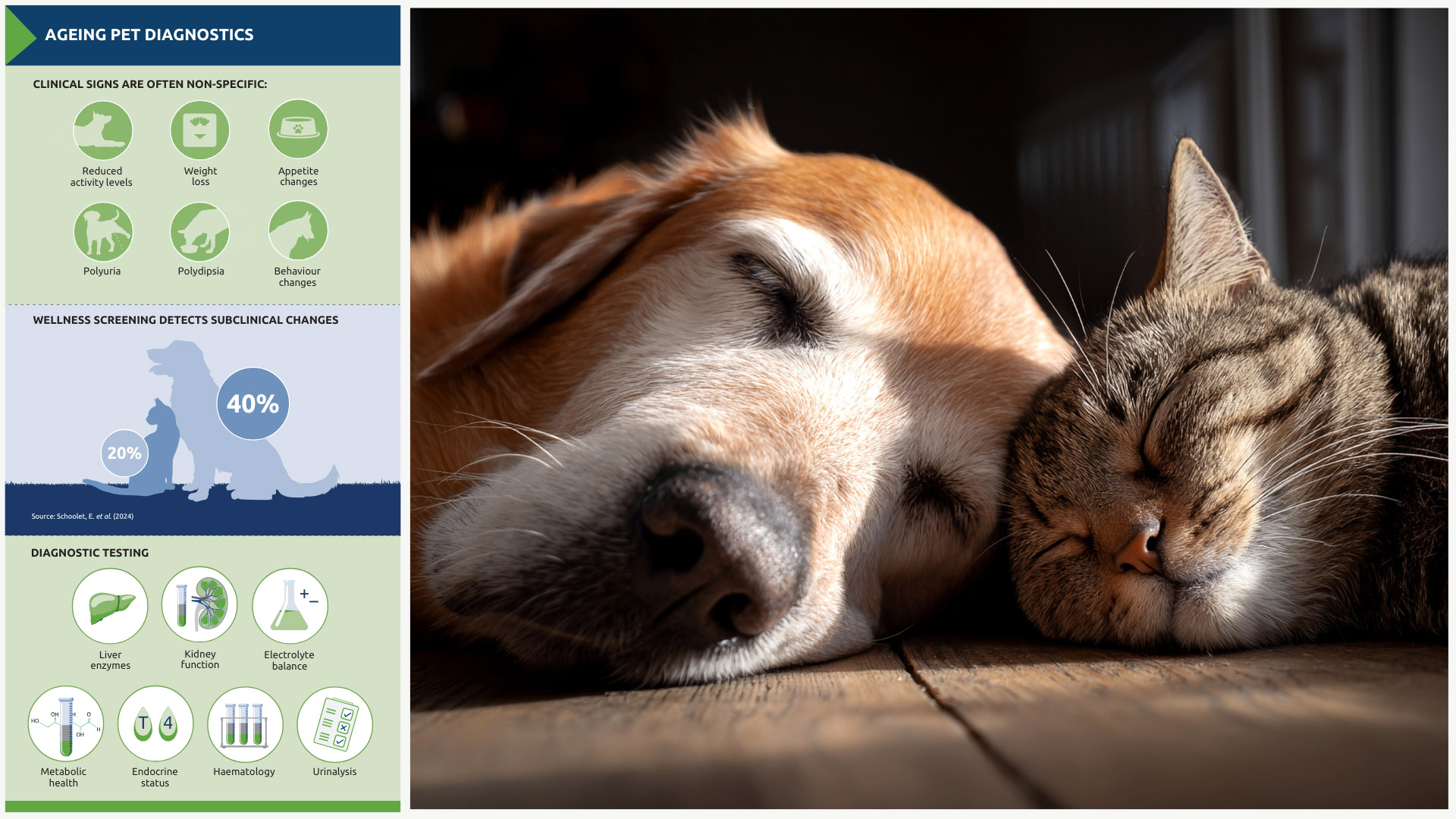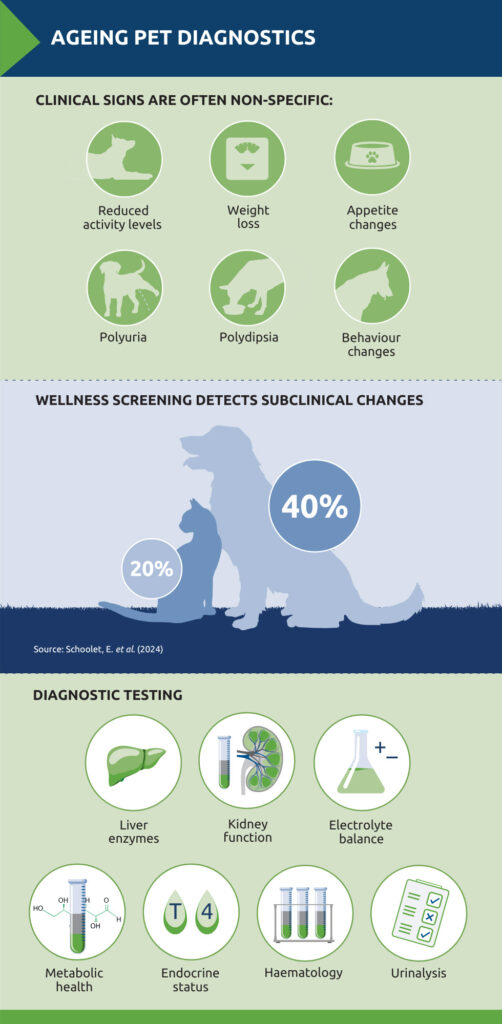Shifting the focus: preventive healthcare and wellness screening in dogs and cats

Author: Sandra Wells
How often does a wellness screen reveal something unexpected in a seemingly healthy pet? The answer is, more often than you might think.
Routine screening in clinically normal dogs and cats offers a vital window for early intervention. And while biochemistry and haematology profiles are central to a proactive approach to diagnosis, newer diagnostic tests, such as cancer biomarker testing and genetic profiling are taking preventive healthcare to another level.
Why screening matters
The 2023 AAHA Senior Care Guidelines emphasise that even apparently healthy pets frequently have underlying abnormalities detectable on routine testing. For this reason, they recommend a minimum diagnostic database that may include haematology, serum biochemistry (with SDMA where available), and urinalysis, at least annually, and in some cases every six months.1 Such screening not only provides baseline values for future comparison but also identifies early changes before clinical signs are apparent. This proactive approach offers the best opportunity for improved long-term outcomes.
Most importantly, abnormalities often occur across multiple systems, underscoring the value of comprehensive wellness panels over targeted testing alone.
A strong foundation
Routine blood screening is therefore a key aspect of preventive care. Biochemical profiles give a snapshot of organ function, hydration status, electrolyte balance, and
metabolic health. Monitoring parameters such as urea, creatinine, ALT, ALP, calcium and glucose can provide early clues about renal, hepatic, or endocrine disease.
Haematology, meanwhile, offers insight into the status of the immune system, red cell mass, and clotting ability. Whether it’s detecting early anaemia, signs of chronic inflammation, or an unexpected thrombocytopenia, changes in a complete blood count can often pre-empt outward signs of illness. Manual blood smears remain a valuable adjunct to automated analysers.
Blood smear preparation
- Prepare smears immediately after collection
- EDTA may distort cell morphology
- Smears should have an area where blood cells are in a monolayer
- The monolayer provides the best view of cell morphology
- Use capillary blood if parasitaemia is suspected
Screening with age in mind
While wellness screening is valuable at any life stage, its importance grows as pets enter their senior years. Subtle clinical changes are often normalised by owners as ’just old age,’ but these can mask underlying disease. Laboratory screening offers an objective way to distinguish natural ageing from pathology, providing opportunities for earlier intervention.
In a study of dogs and cats presenting to veterinary clinics for wellness visits, over 20 percent of senior dogs had alterations suggestive of liver or renal disease, while abnormalities suggestive of endocrine or kidney disease were present in over 40 percent of senior cats.2
The AAHA Guidelines also emphasise that wellness programmes should ideally extend beyond biochemistry and haematology to include urinalysis, blood pressure measurement, mobility assessment, and dental evaluation. Cognitive function is another area where early recognition can improve quality of life, supporting timely advice on environmental modification, diet, and medical intervention. Owner engagement is key. Tools such as the Ageing Canine Toolkit (ACT) , developed by the University of Liverpool with support from BSAVA PetSavers and NationWide Laboratories, empowers owners to recognise and record subtle changes at home. This not only helps clinicians detect issues sooner but also makes screening conversations more meaningful.
Key diagnostics in senior wellness screening
A structured diagnostic approach helps detect the complex, overlapping conditions common in ageing dogs and cats. Core components include:
- Kidney function – SDMA, urea, creatinine
- Liver enzymes – ALT, ALP, GGT
- Electrolyte balance – sodium, potassium, chloride, Na:K ratio
- Metabolic health – glucose, cholesterol
- Endocrine status – total T4
- Haematology
- Urinalysis

Looking to the future
Alongside biochemistry and haematology, emerging diagnostic tools such as DNA profiling and cancer biomarkers are beginning to transform preventive care.
DNA profiling is increasingly being used to identify inherited health risks before they manifest clinically. Beyond satisfying owner curiosity about breed composition, DNA testing can flag predispositions to conditions such as cardiomyopathies, bleeding disorders, and degenerative diseases, supporting a more personalised approach to lifelong monitoring and preventive care.
Similarly, blood-based cancer biomarker tests such as Nu.Q® are opening new possibilities for earlier cancer detection. By measuring circulating nucleosomes (fragments of DNA released during cell death), Nu.Q® can flag dogs that may benefit from further investigation. Its growing clinical relevance highlights how diagnostics are moving towards earlier, proactive intervention.
Integrating screening into veterinary practice
With so many diagnostic tools now available, the challenge for many veterinary teams lies not in recognising their value, but in embedding them into day-to-day workflows. Fortunately, wellness screening needn’t be complex or time-consuming. It’s often about identifying the right opportunities and building them into routine care.
Annual health checks, pre-anaesthetic assessments, and senior pet reviews all present ideal touchpoints for screening. These appointments offer a natural context to recommend baseline biochemistry and haematology and, where appropriate, complementary tests such as DNA profiling or cancer biomarker screening. When presented as part of a structured, lifelong health plan, many owners are not only receptive but appreciative of the added insight.
By embracing these innovations and integrating them into routine protocols, we can shift the focus to proactive, personalised veterinary care.
References
1. Dhaliwal, R. et al. (2022) 2023 AAHA Senior Care Guidelines for Dogs and Cats. Journal of the American Animal Hospital Association. 59. 1-21. 10.5326/JAAHA-MS-7343.
2. Schoolet, E. Hegarty, E. & Michael, H. T. (2024) Frequency of Laboratory Abnormalities in Dogs and Cats Presenting to Veterinary Clinics in the United States for Wellness Visits. https://papers.ssrn.com/sol3/papers.cfm?abstract_id=5010477
About the author
Sandra Wells, Head of Operations at NationWide Laboratories
Sandra Wells holds a BSc (Hons) in Applied Biology with Biochemistry from Coventry University and a postgraduate qualification in Molecular Biology from Lancaster University. Throughout her career, she has held senior roles including Head of Biochemistry, Laboratory Manager, and Group Quality Manager. At NationWide Laboratories, she oversees operations across all sites, leading teams and managing strategic projects. Her scientific background supports the implementation of diagnostic protocols including wellness screening, helping veterinary teams detect disease earlier.
Original publication: Veterinary Edge, issue 56, October 2025, pp 36-37


